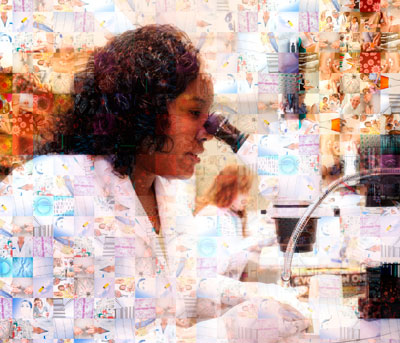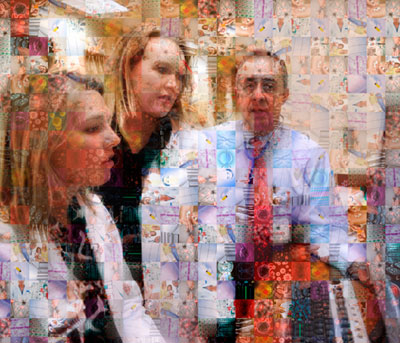UAB Comprehensive Centers Translate Science Into Solutions
By Charles Buchanan |
It’s easy to envision the comprehensive centers as umbrellas, covering every specialist with an interest in a particular disease, but bridges are the better metaphor, Watts explains. Not only do the comprehensive centers connect different disciplines, but they also link the basic scientists in their labs with the clinicians—and the patients—in care settings, opening a clear pathway to translate new discoveries into new treatments.
Comprehensive centers have yielded decades of breakthroughs at UAB, and today they play a central role in AMC21, the School of Medicine/UAB Health System strategic plan to evolve into the preferred academic medical center for the 21st century. “By concentrating our efforts and investing our resources in comprehensive centers, we can make a stronger impact in translational medicine,” Watts says. Many existing comprehensive centers will be expanded, and two new ones, focusing on cardiovascular diseases and transplant medicine, have been established. Institutional investments for the centers, leveraged by philanthropy, are fueling a broad range of collaborative research projects, and faculty recruitments to fill gaps in expertise are also forging new links among centers.
Strength in Numbers
The renewed focus on comprehensive centers could also help UAB researchers win vital grants in the tightest funding environment in the history of the National Institutes of Health (NIH). “The days of the lone scientist are over,” Watts explains. “The NIH is encouraging investigators to collaborate on innovative proposals. The competition is extremely tough, but our comprehensive centers have established a platform for team-based translational research. They are the key to securing multimillion-dollar grants that will fund new clinical trials,” he says, “and they will enable us to create the future of medicine.”
Concentrated Efforts: Comprehensive Centers in Action
Fast Track for a Glioma Breakthrough
UAB’s comprehensive centers already are brightening the future of glioma treatment by giving the breakthrough from Sontheimer’s team a life beyond the laboratory.
 |
Last September, the researchers announ-ced that they had identified the neuro-transmitter glutamate as the link between malignant gliomas and the onset of epileptic seizures—often the first symptom of a brain tumor. While neurons normally use glutamate to communicate with each other, glioma cells “produce an enormous amount, 100-fold beyond normal,” says Sontheimer, a neurobiology professor and director of the Civitan International Research Center (CIRC). “This leads to a state of hyper-excitability that overwhelms healthy neurons and leads to their death,” clearing space for the tumor to grow. Excess glutamate can also cause abnormal electrical activity in the brain, leading to epileptic seizures.
There was also a happy surprise: The researchers found that sulfasalazine, a drug used to treat Crohn’s disease, seems to prevent gliomas from releasing large amounts of glutamate. As a result, nearby neurons stay alive, the tumor’s growth slows, and seizures are inhibited. Sulfasalazine in its current form isn’t a perfect glioma drug—it’s designed to break apart in the intestines, so about 20 percent of it moves into the bloodstream where it could travel to the brain. Still, Sontheimer knew the drug could be an immediate help to glioma patients.
Different Tool Chests
“Having an FDA-approved drug paved the way for a clinical trial in patients very quickly,” Sontheimer says. But his lab didn’t have all the resources it needed to conduct the trial—or the access to patients. “There’s no way you can do translation as a Ph.D. unless you’re surrounded by clinicians,” he explains. Fortunately, he was able to rely upon not one but three comprehensive centers—the Comprehensive Neuroscience Center (CNC), the Comprehensive Cancer Center (CCC), and the CIRC—for assistance.
Behavioral neurobiology director Adrienne Lahti, M.D., a CNC member with Sontheimer, came on board along with neuro-oncology director Burt Nabors, M.D., a CCC scientist. “The centers bring together people who have a common interest but not necessarily a common tool chest,” Sontheimer says. “Dr. Nabors sees patients who present with gliomas. Dr. Lahti is an expert in the use of magnetic resonance spectroscopy, which can identify changes in glutamate content in the brain with both spatial and temporal resolution.”
In January, just four months after the breakthrough’s announcement, the multidisciplinary team began enrolling the first patients into a clinical trial of sulfasalazine, with Nabors as principal investigator. All three centers contributed to a $100,000 AMC21 pilot grant that set the clinical trial in motion, giving the researchers the opportunity to gather enough data to submit a joint proposal to the NIH for a larger clinical study on the treatment of tumor-related epilepsy by the end of the year.
| Two new comprehensive centers are exploring the frontiers of their fields to discover new treatments that could transform patients' lives: Read how the UAB Comprehensive Cardiovascular Center plans to harness new biological therapies that could potentially reverse heart disease. Then learn how the UAB Comprehensive Transplant Institute is taking a big-picture approach to help recipients and donors before, during, and after transplantation. |
Going Beyond the Limits
“This is an example where people from different departments, different backgrounds, and with different techniques come together,” Sontheimer says. “It’s fair to say that none of this would have happened if not for our comprehensive centers.”
Lori L. McMahon, Ph.D., CNC director and holder of the Jarman F. Lowder Endowed Professorship in Neuroscience, calls the Sontheimer-Lahti-Nabors project a “beautiful example of using an animal model of human disease, figuring out the molecular mechanism, and translating it to humans—and one that’s happening really fast.”
In neuroscience, “therapeutic tools for diseases such as Alzheimer’s and gliomas can be limiting,” McMahon says. “Clinicians rely on basic scientists to understand disease mechanisms and identify new targets for therapeutic development. Translational research doesn’t happen everywhere, but at UAB we have strengths at the bench with experimental models and preclinical models, and we also have clinical expertise to take advantage of those findings. It’s a great cross-fertilization.”
No Immunity for Breast Cancer
The next potential breakthrough against cancer may owe its existence to a cup of coffee. In collaborative science, “the key is the exchange of ideas, techniques, data, and constructive commentary on that data as it’s generated,” says immunologist Robert P. Kimberly, M.D., the Howard L. Holley Research Chair in Rheumatology and School of Medicine senior associate dean for research. “Sometimes that means working in the same physical space, but more important is getting together to discuss ideas and review data, which is facilitated by open laboratories, meeting rooms, and places to gather for coffee or tea.”
Several years ago, one big topic of discussion in the Comprehensive Arthritis, Musculoskeletal, and Autoimmunity Center was the mechanism of apoptosis, or cell death—and how that could be applied to cancer cells. “Nature has given us a series of ‘death receptors’—cell surface molecules that can transmit a ‘death signal’ directing the cell to die,” Kimberly explains. “It seems reasonable that the immune system would use this mechanism to kill abnormal cells. If we could develop a monoclonal antibody that recognizes and activates the death receptor, we could boost a natural mechanism.”
The TRA8 antibody was developed by UAB immunologist Tong Zhou, M.D., along with Kimberly and Kimi Ichikawa, Ph.D., from UAB pharmaceutical partner Daiichi Sankyo Inc. They introduced a stimulus that mimics the human death receptor into an animal model, then sifted through the resulting antibodies to identify the relevant one. Translational studies in petri dishes and animal models followed to determine if—and how well—TRA8 worked at causing cancer cell death. It was an exciting discovery, the scientists say, because at the time, few believed that an antibody could directly induce apoptosis.
 |
Targeting the Death Receptor
UAB’s Comprehensive Cancer Center, which conducted the first-ever trial of a genetically engineered monoclonal antibody in the 1980s and has continued to pioneer the field, was eager to bring the humanized form of TRA8, known as tigatuzumab, to patients. The antibody is a particularly promising cancer treatment because it binds to the death receptor on tumor cells only, triggering their death while preserving the surrounding healthy cells. In translational studies, it had shown promise as a treatment for breast, colon, lung, pancreatic, brain, and prostate cancer.
“Translational therapeutics provides a way for UAB to make a difference,” says Edward E. Partridge, M.D., director of the Comprehensive Cancer Center and the Evalina B. Spencer Chair in Oncology. “We want patients to know that when they come here, they have the opportunity to benefit from the most cutting-edge therapeutics for their particular cancer.”
Turning Point
Andres Forero, M.D., a hematologist-oncologist and holder of the O’Neal-Sokol Breast Cancer Research Foundation of Alabama Endowed Professorship, led a team on a phase 1 study of tigatuzumab to determine the maximum safe dosage and any side effects. (They found minimal negative reactions or none at all.) Today, he, along with radiation oncologist Donald Buchsbaum, Ph.D., and others, is directing the first trial of tigatuzumab for patients with metastatic triple negative breast cancer. The national, phase 2 trial involves UAB and the 15 other members of the Translational Breast Cancer Research Consortium, a network of the country’s leading breast cancer research centers; support for the tigatuzumab studies has come from the Breast Cancer Research Foundation of Alabama and a $6.4-million Promise Grant from the Susan G. Komen for the Cure Foundation and the Triple Negative Breast Cancer Foundation.
In the trial, researchers are combining tigatuzumab with chemotherapy—a treatment that could be a turning point for patients with triple negative breast cancer, which accounts for about 25 percent of all breast cancers. This form of the disease “is highly aggressive and most often seen in young African-American and Hispanic women,” Forero explains. “Treatment options are limited because the tumor cells are negative for estrogen receptors, progesterone receptors, and amplification of the HER2 gene.
“Triple negative breast cancer has a very poor prognosis, but of all breast cancers, triple negative shows the greatest response to tigatuzumab,” Forero notes.
Proof of Progress
Though the trial is ongoing, Kimberly says the lessons of the collaborative approach to tigatuzumab are clear. “The ability to work in a flexible team, gathering expertise in the most fundamental science and carrying it through to clinical application, has been central to moving this program forward,” Kimberly says.
“It’s a perfect example of UAB’s strength,” Forero adds. “It’s a major accomplishment and incredibly exciting.”
Taking a Diabetes Discovery to Heart
There’s a reason the multidisciplinary model of research has worked so well for UAB’s comprehensive centers: It mimics real life. Diabetes, for instance, doesn’t care much for departmental boundaries. Its risk factors and complications touch nearly every specialty in the School of Medicine.
So when Anath Shalev, M.D., director of the UAB Comprehensive Diabetes Center and the Nancy R. and Eugene C. Gwaltney Family Endowed Chair in Juvenile Diabetes Research, and her team discovered that a common high-blood-pressure drug appears to reverse the diabetes-related death of pancreatic beta cells, it was a win for UAB cardiovascular researchers as well.
 |
The TXNIP Link
For years, Shalev and colleagues have been studying methods of designing a drug to shut down the TXNIP protein. They had previously established that high blood sugar activates the TXNIP gene, and that excessive TXNIP signaling triggers the self-destruction of insulin-producing beta cells. They also knew that 67 percent of the nearly 26 million adult patients with diabetes suffer from high blood pressure, so they tested the drugs that treat the condition, including the calcium-channel blocker verapamil. And it worked. In cell studies, verapamil reduced TXNIP gene expression by half; in animal models, the drug maintained normal glucose level, with isolated islets showing an 80 percent reduction in TXNIP levels.
“Finding an oral medication that inhibits beta cell TXNIP expression is a major breakthrough, and now we have the first study showing that a drug already proven safe in years of clinical practice may halt the development of diabetes,” Shalev says.
But this breakthrough is just beginning. Cardiovascular researchers John C. Chatham, D.Phil., and Martin E. Young, Ph.D., have joined forces with Shalev to explore verapamil’s potential use in the treatment of heart disease. “TXNIP is found in a host of different tissues and organs, including the heart, where it exerts many different functions,” says Young, an associate professor in cardiovascular disease. “Due to its ability to enter the mitochondria, TXNIP holds the promise of potentially impacting metabolism, and therefore function, in the heart.”
“Patients with diabetes have a much higher risk for a range of different cardiovascular diseases, so we want to understand how TXNIP contributes to some of the adverse effects of diabetes on the heart,” says Chatham, director of the Division of Molecular and Cellular Pathology and co-director of the new Comprehensive Cardiovascular Center. “Verapamil might be more challenging in the heart because it has a direct effect on cardiac function, but if we can identify some of its mechanisms for regulating TXNIP expression, then we could find new therapeutic targets.”
Double Disciplines
It’s a natural connection, the researchers say. Chatham and Young have provided laboratory equipment and technical expertise for Shalev’s studies, and she has done the same for their investigations. Shalev also shares a longstanding interest in the effects of diabetes on the heart, and Chatham and Young are members of the Comprehensive Diabetes Center.
Sharing knowledge and ideas about diabetes and cardiovascular disease is particularly important, considering how the two intertwine, Young adds. “Studying one of these in isolation can hinder identification of clinically relevant mechanisms,” Young says. “Our understanding of the specific links between diabetes and cardiovascular disease is in its infancy.”
Chatham says that he, Young, and Shalev are in the early stages of their collaboration to assess the impact of TXNIP in the heart and that they meet regularly to discuss their intersecting interests, the resources they can share, and potential experiments. Ultimately, they will develop a research project they can submit to the NIH or another funding source. “Even though we’re all interested in the same thing, it takes a while to find the right angle that will take advantage of all of our respective knowledge,” Chatham says. “It’s always a stimulating exercise.”
“Each area of medicine is so highly specialized,” says Shalev, “but we don’t want to be bound by our own expertise.”
Additional reporting by Bob Shepard, Josh Till, and Greg Williams